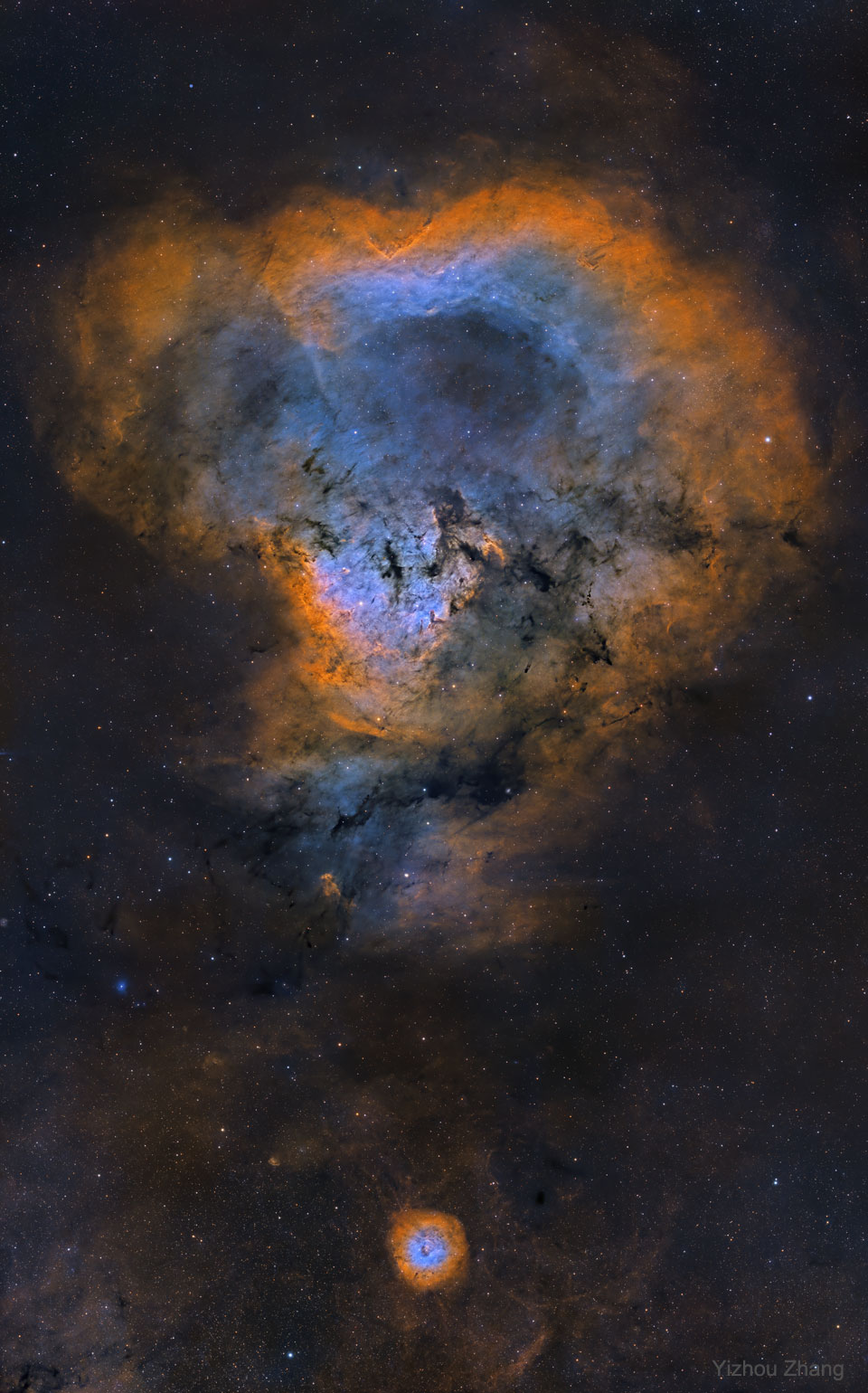13. October 2021
NGC 7822:宇宙 ê 問號

探索宇宙1!逐工會揀一幅無仝款 ê 影像抑是相片,𤆬你熟似咱這个迷人 ê 宇宙,閣有專業天文學者2為你解說3。
- 原始文章:NGC 7822: Cosmic Question Mark
- 影像來源 kah 版權:Yizhou Zhang
- 台文翻譯:An-Li Tsai (NCU)
[漢羅] NGC 7822:宇宙 ê 問號
這看起來敢若是一个大型 ê 宇宙問號。 毋閣上大 ê 問題是欲按怎 ùi 較光 ê 氣體 kah 較暗 ê 塗粉 來解說星雲 ê 恆星形成 歷史。 Tī 北方仙王座方向 ê 巨型 分子雲 邊仔,有發光 ê 恆星形成區 NGC 7822,to̍h chhāi tī 3000 光年 遠 ê 所在。 Tī 星雲內底,較光 ê 邊界 kah 較暗 ê 外形,tī 這張彩色細節 ê 天景攏足出眾 ê。 這是 9 張 ê 拼鬥圖,是用細台望遠鏡 tī 德州 開 28 暗 ê 時間翕 ê。 伊嘛有敆 狹頻 濾鏡 ê 影像資料,kā 酸素原子、水素原子、kah 硫磺原子 ê 發射線用藍色、青色、kah 紅色來表示。 這款 發射線 kah 色彩 ê 組合,這馬已經是逐家攏知 ê 哈伯色盤。 原子發射線是中心高溫恆星 強力輻射 驅動 ê。 強風 kah 強輻射會雕塑、侵蝕 厚密 ê 雲柱,煞落來會 tī 這个幾若光年闊、會產生新恆星 ê 星雲 掃出一个 典型 ê 閬空。 恆星會因為 重力崩塌,繼續 tī 雲柱內底 形成。 毋閣等雲柱予侵蝕了了了後,to̍h 無 材料 繼續做新 ê 恆星矣。 按照 NGC 7822 ê 距離來推算,這个視場有超過 40 光年 闊。
[POJ] NGC chhit-pat-jī-jī: Ú-tiū ê būn-hō
Che khòaⁿ–khí-lâi ká-ná sī chi̍t-ê tōa-hêng ê ú-tiū būn-hō. M̄-koh siōng-tōa ê būn-tê sī beh án-ná ùi khah-kng ê khì-thé kah khah-àm ê thô͘-hún lâi kái-soeh seng-hûn ê hêng-chhiⁿ hêng-sêng le̍k-sú. Tī pak-hong Sian-ông-chō hong-hiòng ê kū-hêng hūn-chú-hûn piⁿ-á, ū hoat-kng ê hêng-chhiⁿ-hêng-sêng-khu NGC chhit-pat-jī-jī, to̍h chhāi tī saⁿ-chheng kng-nî hn̄g ê só͘-chāi. Tī seng-hûn lāi-té, khah-kng ê pian-kài kah khah-àm ê gōa-hêng, tī chit-tiuⁿ chhái-sek sè-chiat ê thian-kéng lóng chiok chhut-chiòng ê. Che sī kàu-tiuⁿ ê pheng-tàu-tô͘, sī iōng sè-tâi bōng-oán-kiàⁿ tī Tek-chiu khai jī-cha̍p-poeh àm ê sî-kan hip ê. I mā ū kap e̍h-pîn lū-kiàⁿ ê iáⁿ-siōng chu-liāu, kā sng-sò͘ goân-chú, chúi-sò͘ goân-chú, kah liû-hông goân-chú ê hoat-siā-sòaⁿ iōng nâ-sek, chheⁿ-sek, kah âng-sek lâi piáu-sī. Chit-khoán hoat-siā-sòaⁿ kah sek-chhái ê cho͘-ha̍p, chit-má í-keng sī ta̍k-ke lóng chai ê Ha-peh-sek-pôaⁿ. Goân-chú hoat-siā-sòaⁿ sī tiong-sim ko-un hêng-chhiⁿ kiông-le̍k hok-siā khu-tōng ê. Kiông hong kah kông hok-siā ē tiau-sok, chhim-sit, kāu-ba̍t ê hûn-thiāu, soa̍h-lo̍h-lâi ē tī chit-ê kúi-ā kng-nî khoah, ē sán-seng sin hêng-chhiⁿ ê seng-hûn sàu-chhut chi̍t-ê tián-hêng ê làng-khong. Hêng-chhiⁿ ē in-ūi tiōng-le̍k-pang-thap, kè-sio̍k tī hûn-thiāu lāi-té hêng-sêng. M̄-koh tán hûn-thiāu hō͘ chhim-sit liáu-liáu liáu-āu, to̍h bô châi-liāu kè-sio̍k chò sin ê hêng-chhiⁿ ah. Àn-chiàu NGC chhit-pat-jī-jī ê kū-lî lâi thui-sǹg, chit-ê sī-tiûⁿ ū chhiau-kòe sì-cha̍p kng-nî khoah.
[KIP] NGC tshit-pat-jī-jī: Ú-tiū ê būn-hō
Tse khuànn-khí-lâi ká-ná sī tsi̍t-ê tuā-hîng ê ú-tiū būn-hō. M̄-koh siōng-tuā ê būn-tê sī beh án-ná uì khah-kng ê khì-thé kah khah-àm ê thôo-hún lâi kái-sueh sing-hûn ê hîng-tshinn hîng-sîng li̍k-sú. Tī pak-hong Sian-ông-tsō hong-hiòng ê kū-hîng hūn-tsú-hûn pinn-á, ū huat-kng ê hîng-tshinn-hîng-sîng-khu NGC tshit-pat-jī-jī, to̍h tshāi tī sann-tshing kng-nî hn̄g ê sóo-tsāi. Tī sing-hûn lāi-té, khah-kng ê pian-kài kah khah-àm ê guā-hîng, tī tsit-tiunn tshái-sik sè-tsiat ê thian-kíng lóng tsiok tshut-tsiòng ê. Tse sī kàu-tiunn ê phing-tàu-tôo, sī iōng sè-tâi bōng-uán-kiànn tī Tik-tsiu khai jī-tsa̍p-pueh àm ê sî-kan hip ê. I mā ū kap e̍h-pîn lū-kiànn ê iánn-siōng tsu-liāu, kā sng-sòo guân-tsú, tsuí-sòo guân-tsú, kah liû-hông guân-tsú ê huat-siā-suànn iōng nâ-sik, tshenn-sik, kah âng-sik lâi piáu-sī. Tsit-khuán huat-siā-suànn kah sik-tshái ê tsoo-ha̍p, tsit-má í-king sī ta̍k-ke lóng tsai ê Ha-peh-sik-puânn. Guân-tsú huat-siā-suànn sī tiong-sim ko-un hîng-tshinn kiông-li̍k hok-siā khu-tōng ê. Kiông hong kah kông hok-siā ē tiau-sok, tshim-sit, kāu-ba̍t ê hûn-thiāu, sua̍h-lo̍h-lâi ē tī tsit-ê kuí-ā kng-nî khuah, ē sán-sing sin hîng-tshinn ê sing-hûn sàu-tshut tsi̍t-ê tián-hîng ê làng-khong. Hîng-tshinn ē in-uī tiōng-li̍k-pang-thap, kè-sio̍k tī hûn-thiāu lāi-té hîng-sîng. M̄-koh tán hûn-thiāu hōo tshim-sit liáu-liáu liáu-āu, to̍h bô tsâi-liāu kè-sio̍k tsò sin ê hîng-tshinn ah. Àn-tsiàu NGC tshit-pat-jī-jī ê kū-lî lâi thui-sǹg, tsit-ê sī-tiûnn ū tshiau-kuè sì-tsa̍p kng-nî khuah.
[English] NGC 7822: Cosmic Question Mark
It may look like a huge cosmic question mark, but the big question really is how does the bright gas and dark dust tell this nebula’s history of star formation. At the edge of a giant molecular cloud toward the northern constellation Cepheus, the glowing star forming region NGC 7822 lies about 3,000 light-years away. Within the nebula, bright edges and dark shapes stand out in this colorful and detailed skyscape. The 9-panel mosaic, taken over 28 nights with a small telescope in Texas, includes data from narrowband filters, mapping emission from atomic oxygen, hydrogen, and sulfur into blue, green, and red hues. The emission line and color combination has become well-known as the Hubble palette. The atomic emission is powered by energetic radiation from the central hot stars. Their powerful winds and radiation sculpt and erode the denser pillar shapes and clear out a characteristic cavity light-years across the center of the natal cloud. Stars could still be forming inside the pillars by gravitational collapse but as the pillars are eroded away, any forming stars will ultimately be cut off from their reservoir of star stuff. This field of view spans over 40 light-years across at the estimated distance of NGC 7822.
詞彙學習(漢羅/POJ/KIP/華語/English)
- 【問號】būn-hō/būn-hō/問號/question mark
- 【仙王座】Sian-ông-chō/Sian-ông-tsō/仙王座/Cepheus
- 【狹頻】e̍h-pîn/e̍h-pîn/窄頻/narrowband
- 【濾鏡】lū-kiàⁿ/lū-kiànn/濾鏡/filter
- 【輻射】hok-siā/hok-siā/輻射/radiation
- 【哈伯色盤】Ha-peh-sek-pôaⁿ/Ha-peh-sik-pûann/哈伯色盤/the Hubble palette
- 【酸素】sng-sò͘/sng-sòo/氧/oxygen
- 【水素】chúi-sò͘/tsuí-sòo/氫/hydrogen
- 【硫磺】liû-hông/liû-hông/硫/sulfer
- 【發射線】hoat-siā-sòaⁿ/huat-siā-sùann/發射線/emission line
- 【雕塑】tiau-sok/tiau-sok/雕塑/sculpt
- 【侵蝕】chhim-sit/tshim-sit/侵蝕/erode
- 【重力崩塌】tiōng-le̍k pang-thap/tiōng-li̍k pang-thap/重力崩塌/gravitational collapse
- 【雲柱】hûn-thiāu/hûn-thiāu/雲柱/pillar